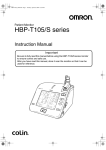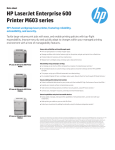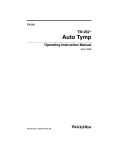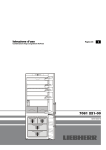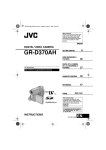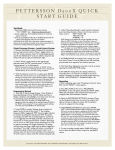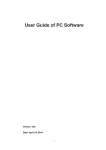Download Casio BP-1MY-1 User's Manual
Transcript
BP-1MY GETTING ACQUAINTED Thank you for purchasing this CASIO product. Be sure you read this User’s Guide before trying to operate it. To ensure your personal safety, make you pay particular attention to the section titled “SAFETY PRECAUTIONS”. BP-1MY-1 KEEPING ATTUNED TO YOUR BLOOD PRESSURE LEVELS Your blood pressure is like a constant message from your body. Monitoring your blood pressure provides you with vital feedback about your current physical condition. High blood pressure, for example, often shows no symptoms of its own, and so except for an abnormally high measurement reading. Left undetected and untreated, high blood pressure can often lead to more serious, life-threatening illness. All of this means that daily blood pressure readings for the purpose of detecting early warning signs from our bodies are an essential part of any comprehensive personal health management program. The CASIO Blood Pressure Monitor Watch and Base Unit make it possible for you to take quick and easy blood pressure readings at home and while you are out. Together, they provide you with essential blood pressure data throughout the day. At home Note • Keep this User’s Guide in a safe place for future reference. • This Blood Pressure Monitor Base Unit is designed for taking accurate blood pressure readings at home or some other fixed location. It displays systolic and diastolic blood pressure values, and pulse rate (BPM). • It is also used for setting basic data on the Blood Pressure Monitor Watch (BP-1B Series). See the “Module No. 2420 User’s Guide” for full details about setting the Watch’s basic data. • All mentions of “Base Unit” in this manual refer to the CASIO Digital Blood Pressure Monitor Base Unit (BP-1MY), and “Watch” refers to the CASIO Blood Pressure Monitor Watch (BP-1B Series). SAFETY PRECAUTIONS Warning • Self-diagnosis of your physical condition based on the measurement results of the Base Unit is extremely dangerous. Make sure you always consult your physician concerning your physical condition. • Do not use a mobile phone or other device that emits radio waves in the vicinity of the Base Unit while taking blood pressure readings. Do not take blood pressure readings in the vicinity of a TV, microwave oven, etc. Doing so can produce incorrect readings. • Never use the Base Unit for any other purpose other than taking blood pressure readings. • Do not use the Base Unit to measure the blood pressure of young children. • Never try to take the Base Unit or cuff apart, and never modify them in any way. Doing so can lead to malfunction of the Base Unit and other serious problems. Batteries Incorrect use of batteries can cause corrosive fluid to leak from them, and creates the risk of fire and personal injury due to exploding batteries. To avoid such problems, make sure you carefully observe the following battery guidelines. • Always make sure that the (+)/(–) polarity of batteries is correct when you load them. • Never mix new batteries with old ones. • Never mix batteries of different types. • Be sure to remove the batteries from the Base Unit if you do not plan to use it for a long time. • Use only the batteries that are specifically recommended for the Base Unit. • Take care when using your fingernail to remove batteries from the battery compartment. Pulling on batteries can cause long nails to break. Handling • Do not use the Base Unit if it appears to be malfunctioning, damaged, etc. While you are out Watch Base Unit Base Unit The Base Unit is a cuff type digital blood pressure monitor that measures your systolic and diastolic blood pressure, as well as your pulse rate. It is also used for setting basic data on the Watch. Watch This Watch measures blood pressure using a fingertip pulse wave detection system. After you use the Base Unit to measure your basic data and send it to the Watch, you can use the Watch to take readings, without applying pressure to your upper arm. Simply place your finger onto the Watch’s sensor and your blood pressure and pulse rate appear in a few moments. The Story of Blood Pressure What is Blood Pressure? Blood pressure represents the change in pressure against the interior of artery walls, which is caused by blood being sent through the circulatory system by each beat of the heart. There are actually two blood pressure values: systolic blood pressure and diastolic blood pressure. Systolic blood pressure is the pressure exerted by the blood when the heart contracts, causing artery walls to expand. Diastolic blood pressure, on the other hand, is the pressure exerted by the blood when the heart expands, and artery walls return to their original shapes. What causes blood pressure to change? A variety of different factors can cause a change in blood pressure, including age, climate, emotional stress, gender, living environment, and basic diet. • Average systolic blood pressure tends to rise with age due to natural loss of elasticity in arterial walls. BP-1MY-2 • Your blood pressure fluctuates throughout the day. Normally, it is at its highest shortly after you awake in the morning, and it reaches its lowest level some time while you are asleep. A fluctuation between maximum and minimum systolic blood pressure levels of about 20mmHg is considered normal. Pressure • When diastolic blood pressure is up to 90mmHg, systolic blood pressure greater than 140mmHg is classified as Isolated Systolic Hypertension, while systolic blood pressure within the range of 140 to 149mmHg is classified as Subgroup: Borderline Isolated Systolic Hypertension. Systolic Blood Pressure (mmHg) Blood Pressure Fluctuation During the Day (Example) kPa mmHg 140 or greater 140 to 149 21.3 160 Diastolic Blood Pressure (mmHg) 18.6 140 Up to 90 Borderline: Subgroup Isolated Systolic Hypertension Isolated Systolic Hypertension 16.0 120 Systolic Blood Pressure (kPa) 13.3 100 10.6 18.6 or greater 18.6 to 19.8 80 Diastolic Blood Pressure (kPa) 8.0 60 5.3 40 Up to 12.0 Borderline: Subgroup Isolated Systolic Hypertension Isolated Systolic Hypertension Sleeping Time 12 18 24 6 12 Bevan, Honour & Stott : Clin. Sci (1969)36,329-344 The above is upper arm blood pressure data. • A rise in blood pressure can be caused by physical exercise, drinking coffee or tea, smoking, the need to urinate, and other factors. • Blood pressure is also affected by your physical condition, as well as stress due to your emotional state, worry, etc. • A blood pressure reading can also be affected by your posture when the reading is taken. Normally, your blood pressure will be lower if you are sitting instead of standing. • Temperature and humidity can also affect blood pressure. Normally, winter blood pressure readings tend to be higher than summer readings. Definitions and Classification of Blood Pressure Levels Though the general rule of thumb for normal systolic (maximum value) blood pressure is your current age plus 90mmHg, this is not always necessarily true. The following chart shows some general guidelines for blood pressure values. • The following tables show classifications for hypertension (high blood pressure) according to the World Health Organization (WHO) and the International Society on Hypertension (ISH) (1999). Diastolic Blood Pressure (mmHg) Up to 80 80 to 84 Systolic Blood Pressure (mmHg) Up to 120 120 to 129 130 to 139 140 to 159 140 to 149 180 or 160 to 179 greater Optimal (target) Normal High-Normal 85 to 89 Subgroup: Borderline 90 to 94 Grade 1 Hypertension (“mild”) 90 to 99 Grade 2 Hypertension (“moderate”) 100 to 109 Grade 3 Hypertension (“severe”) 110 or greater Why is high blood pressure a cause for concern? As its name implies, high blood pressure causes arteries to be exposed to high pressure, and can cause lesions in the arteries that supply blood to brain, heart, liver, and other vital organs. Left untreated, high blood pressure can lead to loss of heart function, hardening of the arteries, and a host of other problems like those described below. • Aneurysms in the brain’s blood vessels, which can lead to stroke • Enlargement of the heart, which can lead to heart failure • Narrowing of blood vessels in the kidney, which can lead to kidney failure • Premature hardening of the arteries throughout the body, especially those in the heart, brain, and kidneys, which can lead to heart attack, stroke, or kidney failure What does low blood pressure indicate? Some symptoms of low blood pressure are chronic fatigue, dizziness, shoulder stiffness, palpitation of the heart, and shortness of breath. Be sure to contact your physician if you suffer from any of these symptoms. Monitoring Blood Pressure Levels on Your Own When is the best time to take readings? You should take readings during which you are most relaxed and stable. It is also important to take readings at the same times everyday, every morning, noon, and night, for example. Of course, you can also take readings at any other time you wish, but the important thing is to take blood pressure readings an integral part of your overall health control activities. Be sure to keep records. Your blood pressure will fluctuate with changes in your physical condition and even the weather. Because of this, you should keep a record that includes not only measured values, but also information about your physical condition and surrounding conditions. Try making it your goal to build an entire year of daily records. • You can make copies of the “Blood Pressure Record” at the back of this manual and use them to keep track of changes in your blood pressure and pulse measurements. Is there anything I should do before taking a reading? Diastolic Blood Pressure (kPa) Up to 10.6 10.6 to 11.2 11.3 to 11.8 12.0 to 12.5 12.0 to 13.2 13.3 to 14.5 14.6 or greater Systolic Blood Pressure (kPa) Up to 16.0 16.0 to 17.217.3 to 18.5 18.6 to 21.2 18.6 to 19.8 Optimal (target) Normal High-Normal Subgroup: Borderline Grade 1 Hypertension (“mild”) Grade 2 Hypertension (“moderate”) Grade 3 Hypertension (“severe”) 24.0 or 21.3 to 23.8 greater First of all, try to relax. Take five or six deep, cleansing breaths. Also, note the following pointers. Take readings in a quiet location. Select a comfortable location that is free of loud noise and vibration, and is neither overly hot nor cold. A temperature of about 20°C is best. Take readings while you are calm. Avoid times when you are worried or otherwise emotionally upset, and after eating, exercise, or drinking coffee. Maintain good posture during readings. Keep your arm and wrist at about the same height as your heart. It is also important to be free if tension. Take readings at the same time everyday. Remember that blood pressure is constantly changing. Try to take your readings at the same time each day. BP-1MY-3 Why are values produced by readings I take at home different from values produced when my doctor takes readings? GENERAL GUIDE 1 Infrared Port Slight tension caused by a visit to the doctor or a hospital can cause blood pressure readings taken there to be a bit higher. This, of course, assumes that you are following the correct procedures when taking your readings at home. It could be due to a condition called “white-coat hypertension.” “White-coat hypertension” is a condition caused by the atmosphere that is present in a hospital. It is an emotional condition, and does not indicate a physical problem. It is important to be relaxed while taking a blood pressure reading. 2 Switch 3 4 Button Button Controlling Blood Pressure Daily Life 5 Display How you live your daily life is an important factor in achieving good blood pressure. Improved living habits and patterns can actually decrease the chance of high blood pressure. The first step on the road to proper living is eliminating overexertion and stress. The following are some proven tips for developing good living habits and enjoying the benefits of good blood pressure. • Reduce salt intake. • Go to bed early and get up early. • Eat regular meals every morning, noon, and night. • Get enough sleep. • Set aside enough time for yourself in order to get some stress relief. • Try to achieve a balance between your mental and physical well being. Exercise Proper exercise plays an important role in controlling blood pressure. The accent here is on the word “proper,” because the wrong type of exercise can actually do more harm than good. Aerobic exercise, such as walking at a comfortable pace, is the best for controlling blood pressure. Healthy Walking Tips Keep your gaze on the ground relatively far in front of you. Keep your head upright and pointed straight ahead. Keep your chest out and your back straight. Keep your chin in. Cuff 1Infrared Port This port is used when transferring data from the Base Unit to the Watch. • See the User’s Guide that comes with the Watch for information about setting basic data. 2 Switch Use this switch to set the maximum estimated systolic pressure value. 3 Button Press this button to toggle power on and off. 4 Button Press this button to start measurement. Pressing this button while measurement is in progress stops the measurement. 5Display The display shows blood pressure and pulse rate values. Display Contents 2 Data communication indicator 3 Inflation indicator 1 Pulse indicator 7 Blood pressure unit Walk briskly in a straight line. Lower your foot to the ground heel first. Let your arms swing forward and back. Take long strides. Other things to remember when exercising! • Keep it brisk, but don’t overdo it! • Don’t forget to warm up and cool down. • Be sure to drink water to replenish lost fluids. • Try to stick to indoor exercises on very hot or very cold days. Important! • Always consult with your physician before undertaking any physical exercise program. 4 Deflation indicator 5 Low battery indicator 6 Measured value 1Pulse indicator Flashes when a pulse is detected. Stops flashing and remains on the display as long as the pulse rate is displayed after measurement is complete. 2Data communication indicator Indicates that data is being sent to the Watch. 3Inflation indicator Flashes when the cuff is being inflated. 4Deflation indicator Flashes when the cuff is being deflated. 5Low battery indicator Indicates that batteries are low. Replace batteries as soon as possible after this indicator appears. • This indicator also appears if batteries are loaded with the (+) and (–) ends facing in the wrong directions. 6Measured value Shows systolic and diastolic blood pressure values, and pulse rate (BPM). 7Blood pressure unit The Base Unit can display blood pressure in units of kPa or mmHg. See “BLOOD PRESSURE UNITS” for more information. BP-1MY-4 # Slide the battery compartment cover back into place to close it. • If display contents appear abnormal after you load batteries, remove the batteries, wait for about two or three seconds, and then reload them. Sample Displays kPa Diastolic Blood Pressure AFFIXING THE CUFF TO YOUR ARM Systolic Blood Pressure Pulse Rate • Affix the cuff to your arm so it is in contact with bare skin. • If you are wearing clothing made of thick material (such as a sweater), it is better to remove the thick clothing than to roll up the sleeve. ! Insert the plug of the cuff into the Base Unit. • Make sure you insert the plug as far as it will go. mmHg Diastolic Blood Pressure Plug Systolic Blood Pressure Connector Pulse Rate • Most of the display illustrations in this manual use kPa (the factory default unit) as the blood pressure measurement unit. BATTERIES Power Requirements • The Base Unit is powered by four AA-size batteries. • Use of batteries recommended by CASIO or their equivalents is recommended. Important! • Replace batteries as soon as possible after the low battery indicator ( ) appears on the display. • Make sure that the (+) and (–) ends of the batteries are oriented correctly when you load them. • Never mix new batteries with old ones. • Never mix batteries of different types. • Be sure to remove the batteries from the Base Unit if you do not plan to use it for a long time. • The original batteries that come with the Base Unit are not rechargeable. Never try to charge them. • The original batteries that come with the Base Unit are loaded at the factory before shipment. Because of time spend in transit and storage, the original batteries may not provide the service life indicated below. • Should batteries ever leak, immediately wipe the fluid from inside the battery compartment, taking care not to get any on your skin. • Keep batteries out of the reach of small children. If a battery is accidentally swallowed, immediately contact a physician. • Leaving old batteries in the Base Unit can cause unexpected problems. • Dispose of used batteries in accordance with the regulations and laws in your particular country or area. Battery Life You can expect approximately 300 measurements from a fresh set of AA-size alkaline batteries (LR6). Loading Batteries ! Pressing down on the ▼ part of the battery compartment cover, slide the cover in the direction indicated by the arrow. • Remove the old batteries, if there are any. To close To open Press here and slide. OPEN @ Making sure that their (+) and (–) ends are oriented correctly, load the new batteries into the battery compartment. @ Widen the opening of the cuff and then slip it over your left arm. The cuff material should form a loop, with the end of the material passing through the oblong metal ring. Pull the end of the material through the ring so the cuff is snug on your arm, double it back against the ring, and secure it in place with the fastening tape. There should be about one or two centimeters between the edge of the cuff and your elbow joint. • The cuff should not be touching your elbow joint. Your hand should be open, palm facing upwards. Position the cuff so the air tube is located at the top of your biceps. • The tube should align approximately with your middle finger. If the end of the material is accidentally pulled out from the metal ring, insert it back in, making sure that the fastening tape is facing outward. • Always have the cuff on your left arm whenever taking readings for the purpose of setting the Watch’s basic data. If you are simply taking readings with the Base Unit only, however, you can have the cuff on your right arm. # Pull on the end of the cuff material until the cuff is snug on your arm, and use the fastening tape to secure it in place. Tighten the cuff until all of the open space between your arm and the cuff is eliminated. • Take care that you do not over tighten the cuff. Fastening tape • Leaving space between the cuff and your arm, can cause over inflation, and apply very strong pressure to your arm. It can also interfere with proper measurement. BP-1MY-5 $ With your hand open and the palm facing upwards, place your elbow on a table or other surface so the center of the cuff is at about height as your heart. @ Press the button to turn on the Base Unit. button right away after you depress it. Do not • Release the button down for more than about a second. hold the • Pressing the button again turns off power. All segments appear momentarily. Center of cuff ▲ • If the center of the cuff is too low, try putting a towel or cushion under your elbow. • Make sure that the air tube does not pass under your arm. No! Flashes Measurement will not start if you press the button while this indicator is flashing. ▲ Yes! Pressure zero-setting in progress. Standby # Press the button. • This starts inflation of the cuff and displays the pressure value. Measurement starting BLOOD PRESSURE UNITS The Base Unit can display blood pressure in units of kPa or mmHg. In the case of kPa, the Base Unit actually measures using mmHg units and then converts the results to kPa. • The initial factory default blood pressure unit is kPa. The unit also returns to kPa whenever you replace Base Unit batteries. To specify the blood pressure unit While the Base Unit is turned off, hold down its button for about three seconds, and then release the button. • The Base Unit will perform its zero reset procedure and then display the standby screen, with the currently selected blood pressure unit indicated at the top. • During measurement, the indicator flashes on the display to indicator stops indicate that the pulse is being detected. The flashing and remains on the display as long as the pulse rate is displayed after measurement is complete. $ After measurement is complete, the displays alternates between the systolic and diastolic blood pressure values, and the pulse rate. Systolic Blood Pressure ▲ mmHg ▲ ▲ ▲ ▲ kPa Diastolic Blood Pressure ▲ Pulse Rate kPa • The above procedure toggles the blood pressure unit between kPa and mmHg. • The blood pressure unit you select remains selected even if you turn off the Base Unit. TAKING A BLOOD PRESSURE READING • Make sure you are relaxed before starting the measurement procedure. • Do not move your arm or the rest of your body while a measurement is in progress. ! Put the cuff on your arm and set the switch to the estimated upper limit of your systolic (high) blood pressure value. % Press the mmHg button to turn off the Base Unit. • An Auto Power Off feature automatically turns off the Base Unit if you leave it on for about three minutes. Note • Avoid taking too many consecutive measurements with the Base Unit. Pressure from the Base Unit cuff can cut off circulation in your arm and cause incorrect readings. Remove the cuff and wait a while before taking another reading. • Correct readings are impossible when diastolic blood pressure is greater than 180mmHg. Re-inflation • If you think your systolic blood pressure is around 17.3kPa (130mmHg) setting. you should select 20.0kPa (150mmHg) as the If the Base Unit determines that pressure in insufficient during a measurement operation, it automatically re-inflates the cuff. Re-inflation may also be performed if you move or talk, or if there is excessive noise or another type of disturbance during a measurement procedure. • Note that positioning the cuff so its air tube underneath your arm (especially when your arm is pressing down on the tube) can cause noise. This can lead to re-inflate or even make proper measurement impossible. BP-1MY-6 Stopping a Measurement PRECAUTIONS DURING USE To stop an ongoing measurement operation, press the button. This causes the Base Unit to deflate the cuff and then go into standby. button also causes the Base Unit to deflate the cuff Pressing the and turn off. Recording Blood Pressure Readings You can make copies of the “Blood Pressure Record” at the back of this manual and use them to keep track of changes in your blood pressure and pulse measurements. ERROR MESSAGES When any of the errors described below occurs, the Base Unit deflates the cuff and then waits for further button operation or data communication with the Watch. Message Err 01 Cause • The Base Unit cannot detect a suitable pulse. Err 02 setting is too low. • • Noise due to body movement. Err 03 • The cuff is not connected to the Base Unit properly, or a hole in the cuff. • The cuff is too loose on the arm. • Check the air tube connection to the Base Unit. • Tighten the cuff so there is no space between your arm and the cuff. • If there is air leaking from the cuff because it is old or it has a hole in it, replace the cuff with a new one. Err 04 value is too low. • • Noise due to body movement. • The cuff is too loose on the arm. • Do not move or speak while measurement is in progress. • Make sure the air tube is not under your arm. • Tighten the cuff so there is no space between your arm and the cuff. Err 44.0 • Increase in cuff pressure due to body movement. • Take care so no pressure is applied to the cuff while measurement is in progress. (kPa) Err 330 (mmHg) Action • Do not move or speak while measurement is in progress. • Make sure the air tube is not under your arm. The appearance of the low battery indicator shown below causes the Base Unit to cancel any ongoing measurement or communication operation and wait for further button operation. Indicator Cause • Battery power is low. Action Replace the Base Unit batteries. TROUBLESHOOTING Check the points noted below whenever you experience operational problems with the Base Unit. Problem Nothing happens when you press the button. What to Check and What to Do • Is battery power low? → Replace the batteries with a full set of new ones. • Are batteries loaded correctly? → Check to make sure that batteries are loaded correctly. Inflation is performed, but the cuff does not inflate. • Is the cuff’s plug connected correctly to the Base Unit? → Check the plug for proper connection. • Is there a hole in the cuff? → Contact the store or dealer where you purchased the Base Unit about replacing the cuff. If the actions recommended above do not correct your problem, the Base Unit itself may be malfunctioning. In this case, contact the store or dealer where you purchased the Base Unit. • Do not leave the Base Unit in areas exposed to direct sunlight or near a heater. • Do not expose the Base Unit to severe vibration or impact. • To clean the exterior of the Base Unit, wipe it with a dry cloth or with a cloth moistened with a weak solution of water and a mild neutral detergent. Wring all excess liquid from the cloth before wiping. Never use thinner, benzene, or other volatile agents for cleaning. Doing so can discolor or damage the case. • Do not submerse the cuff in water or launder it. • Be sure to remove the batteries from the Base Unit if you do not plan to use it for a long time. CASIO COMPUTER CO., LTD. assumes no responsibility for any loss, or any claims by third parties that may arise through the use of the Base Unit. BP-1MY-7 Make extra copies for future use. Blood Pressure Record Date Name: 1 2 3 4 5 6 7 8 9 10 11 12 13 14 15 16 17 18 19 20 21 22 23 24 25 26 27 28 29 30 31 1 2 3 4 5 6 7 8 9 10 11 12 13 14 15 16 17 18 19 20 21 22 23 24 25 26 27 28 29 30 31 Time Date: BLOOD PRESSURE (Unit: mmHg) Notes: Example 250 240 230 220 210 200 190 180 170 160 150 140 130 120 110 100 90 80 70 60 50 40 Pulse Systolic Values Notes Diastolic Values Blood Pressure Record Date Name: Time Date: BLOOD PRESSURE (Unit: kPa) Notes: Example Systolic Values 33.0 32.0 31.0 30.0 29.0 28.0 27.0 26.0 25.0 24.0 23.0 22.0 21.0 20.0 19.0 18.0 17.0 16.0 15.0 14.0 13.0 12.0 11.0 10.0 9.0 8.0 7.0 6.0 Pulse Notes Diastolic Values







